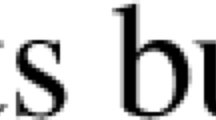Abstract
In this paper we investigate two purely syntactical notions ofcircularity, which we call ``self-application'' and ``self-inclusion.'' Alanguage containing self-application allows linguistic items to beapplied to themselves. In a language allowing for self-inclusion thereare expressions which include themselves as a proper part. We introduceaxiomatic systems of syntax which include identity criteria andexistence axioms for such expressions. The consistency of these axiomsystems will be shown by providing a variety of different models –these models being our circular languages. Finally we will show what apossible semantics for these circular languages could look like.
Similar content being viewed by others
References
Aczel, P., 1980, "Frege structures and the notions of proposition, truth and set," pp. 31–59 in The Kleene Symposium, J. Barwise, H.J. Keisler, and K. Kunen, eds., Amsterdam: North-Holland.
Aczel, P., 1988, Non-Well-Founded Sets, CSLI Lecture Notes 14, Stanford, CA: CSLI.
Barendregt, H., Bunder, M., and Dekkers, W., 1993, "Systems of illative combinatory logic complete for first-order propositional and predicate calculus," Journal of Symbolic Logic 58, 769–788.
Barwise, J. and Etchemendy, J., 1987, The Liar.An Essay on Truth and Circularity,NewYork: Oxford University Press.
Barwise, J. and Moss, L., 1996, Vicious Circles, CSLI Lecture Notes 60, Stanford, CA: CSLI.
Bealer, G., 1982, Quality and Concept, Oxford: Clarendon Press.
Feferman, S., 1984, "Toward useful type-free theories I," Journal of Symbolic Logic 49, 75–111.
Gupta, A. and Belnap, N., 1993, The Revision Theory of Truth, Cambridge, MA: MIT Press.
Halbach, V., 1996, Axiomatische Wahrheitstheorien, Berlin: Akademie-Verlag.
Hindley, J.R. and Seldin, J.P., 1986, Introduction to Combinators and ë -Calculus, Cambridge: Cambridge University Press.
Lloyd, J.W., 1987, Foundations of Logic Programming, 2nd edition, Berlin; Springer-Verlag.
Tarski, A., 1935, "Der Wahrheitsbegriff in den formalisierten Sprachen," Studia Philosophica 1, 261–405. English translation in: Tarski, A., Logic, Semantics, Metamathematics, 2nd edition, Hackett, Indianapolis, pp. 152–278.
Turner, R., 1987, "A theory of properties," Journal of Symbolic Logic 52, 455–472.
Author information
Authors and Affiliations
Rights and permissions
About this article
Cite this article
Leitgeb, H., Hieke, A. Circular Languages. Journal of Logic, Language and Information 13, 341–371 (2004). https://doi.org/10.1023/B:JLLI.0000028335.19112.1d
Issue Date:
DOI: https://doi.org/10.1023/B:JLLI.0000028335.19112.1d




